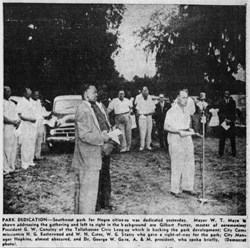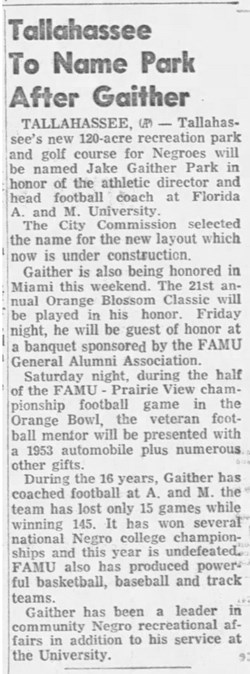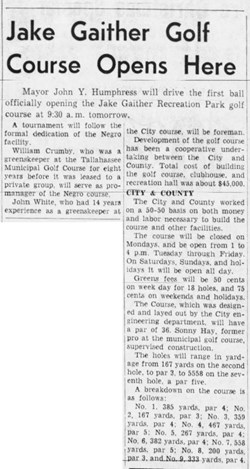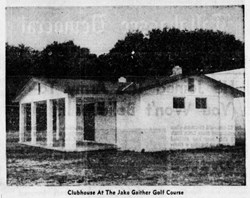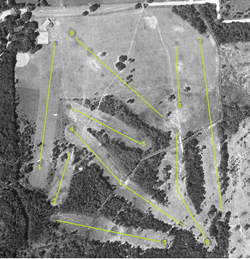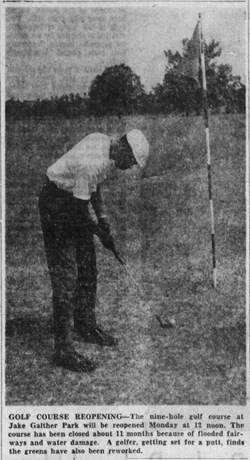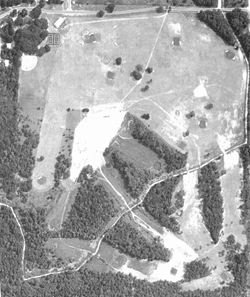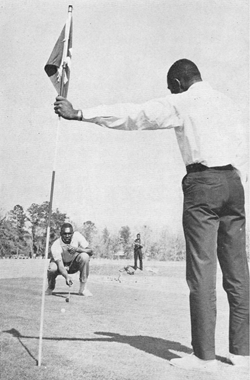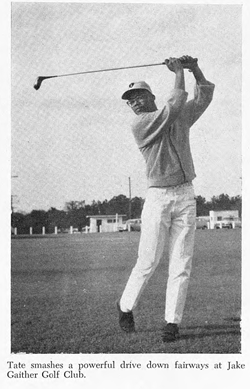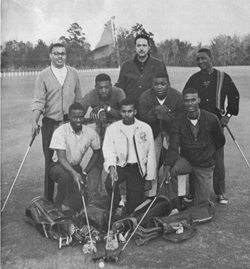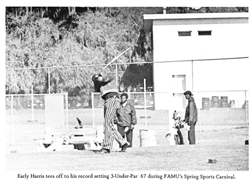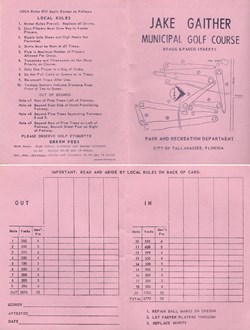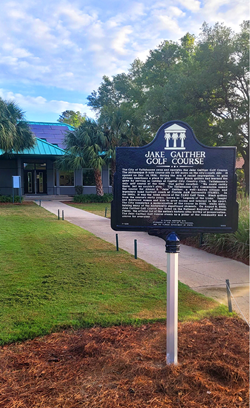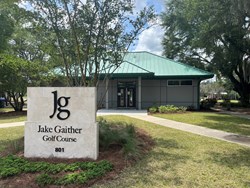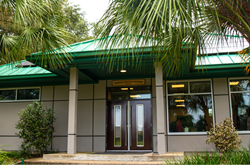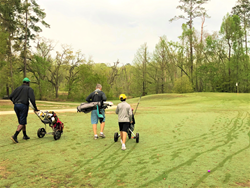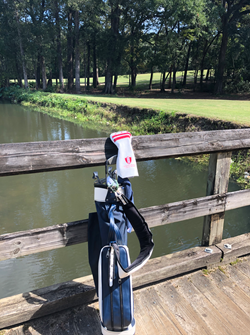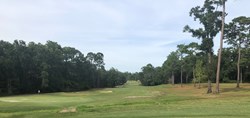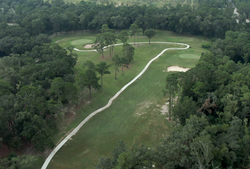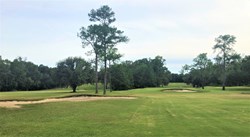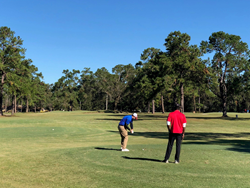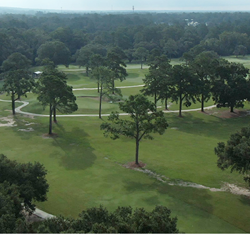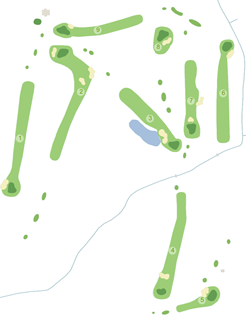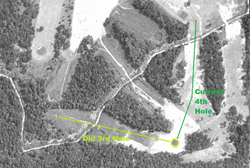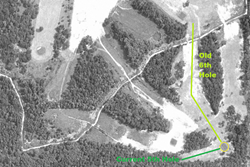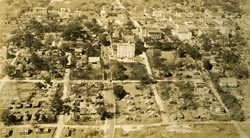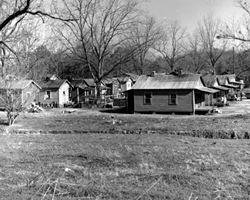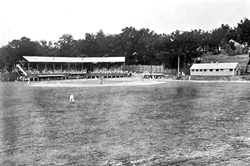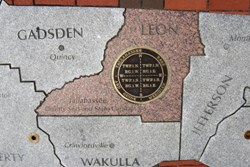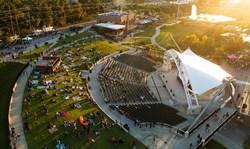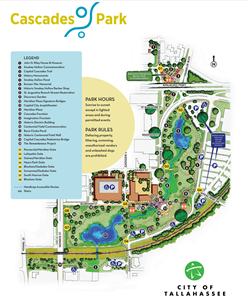Featured Golf Course
In this section learn more about the history of the course and its hometown, see a selection of historic and current images of the course, learn about what the course is like today, and discover nearby historic sites.

Jake Gaither Golf Course
History
The Jake Gaither Golf Course is located in the City of Tallahassee in Leon County.
Starting in 1953, Black residents advocated for the City of Tallahassee to establish a park and golf course for the Black community. The site chosen was a 120-acre tract that was the former pasture land of the Southern Packing Company. In December 1953, the City Commission announced that the new park including the golf course would be named Jake Gaither Park in honor of Alonzo Smith “Jake” Gaither, who was then serving as Florida A&M University (FAMU) athletic director and its head football coach.
During the era of de facto racial segregation that followed the Brown vs. Board decision in 1954, Jake Gaither Golf Course allowed Black golfers to play at any time on a challenging course, which contrasted with privately owned golf clubs from which they were often excluded. Prior to its opening, Black golfers in Tallahassee were limited to working as caddies at segregated golf courses and could only play at these courses at very limited times, if at all.
It was reported that the City Engineering Department designed and laid out the golf course with assistance from Clifford E. "Sonny" Hay Jr., with William Crumbie supervising the construction. Hay had recently left the Tallahassee Country Club (today known as Capital City Country Club) where he served as the head golf professional for 12 years. Crumbie was a Tallahassee native who grew up in the old Smokey Hollow neighborhood, a Black neighborhood located immediately east of the State Capitol. For the previous eight years, Crumbie had worked as a groundskeeper at the same country club. Crumbie became the manager for the new Jake Gaither golf course and John White was hired its golf course foreman. White had 14 years of greens keeping experience at the country club.
The nine-hole, par 36 golf course opened, in December 1956, with a length of 3,118 yards. Holes 3, 4, 6 and 7 took advantage of the elevation on the south side of the parcel where there were as much as 20 to 30 feet in elevation change. Several of the holes (2, 3, 4, and 5), were routed into and/or through the wetlands and across the drainage ditch.
Unfortunately, flooding issues affected the golf course over the next several years. At the November County Commission meeting in 1960, City Manager Arvah Hopkins and City Engineer Miller Walston appeared before the County Commissioners and requested their cooperation in renovating the golf course. The redesign would require a considerable amount of moving dirt to build three new tees and four new greens. The City authorized an estimated $2,500 to redesign the golf course to help with the flooding issues. Walston was in charge of the course redesign and Crumbie was recruited to help rearrange the unplayable holes and create better routing which would remain dry in wet weather. The redesign eliminated holes subject to flooding and rerouted several others to wrap around wetlands.
Over the next few years, the Jake Gaither Golf Course continued to be open for play and hosted many golf tournaments. The Florida Agricultural and Mechanical University (FAMU) Golf Team used it in the 1950s, 1960s, and through the early 1970s as their home course. Also, throughout the 1960s and into the early 1970s, the FAMU Golf Team hosted their Spring Sports Carnival and golf tournaments at the golf course.
On August 9, 2022, Jake Gaither Golf Course was officially listed in the National Register of Historic Places. “I am pleased to announce that Jake Gaither Golf Course has been listed in the National Register of Historic Places,” said Florida Secretary of State Cord Byrd. "This golf course served as the only public venue for Tallahassee’s African American golfers in the 1950s and 1960s. Today, it welcomes all golfers and promotes the growth of the game by offering a challenge to players of all skill levels and abilities.”
More recent changes have made the golf course more playable. The current layout and appearance dates from 1998, but the 9-holes still follow historic routing established in the 1960 redesign.
Today
The 9-hole, par-36 Jake Gaither Golf Course features three sets of tees playing from 2,400 to 3,100 yards. The course offers a pro shop with golf merchandise and snack items, a practice putting green, and rental clubs. The entire course was renovated in 1998 and the additional teeing areas makes the course very enjoyable for all level of golfers.
From its beginning, Jake Gaither Golf Course offered lessons and instruction to interested youth, hosted tournaments for Black players, and served as the primary golf course for the Florida A&M golf team for many years. Following the passage of national civil rights legislation in the mid-1960s, the golf course diversified in membership.
Today, Jake Gaither Golf Course shines brighter than ever, welcoming thousands of golfers each year from every walk of life and it remains a fixture in Tallahassee’s golf community and an important piece in the history of the local civil rights movement.
Local Knowledge
When the city redesigned the golf course in 1960, they incorporated two of the existing greens from the original layout.
The current 4th hole used the green from the old 3rd hole. The old 3rd hole began near the near the back tee on the current 2nd hole. The fairway ran through the woods, crossed the canal and up the side of the hill to the current 4th green.
The current 5th hole used the green from the old 6th hole. The tee box for the old 6th hole is in the same location as the current 4th hole. The old 6th was a dog leg to the left ending at the current 5th green.
Inside the Leather
Cascades Park - A 24-acre classroom, Cascades Park is the perfect place to learn all about Tallahassee's early years. From the founding of Tallahassee with Florida's first point of origin in the Prime Meridian Plaza to life in the 1900s with the Smokey Hollow Commemoration, it can all be found here in Cascades Park. Jake Gaither Golf Course’s first manager, William Crumbie, grew up in the old Smokey Hollow neighborhood and began working as a caddy at nearby Capital City Country Club.
Visit Cascades Park for more details.
Visit - Contact
Jake Gaither Golf Course
801 Bragg Drive
Tallahassee, Florida 32305
801 Bragg Drive
Tallahassee, Florida 32305
View the Website
Phone:
850.891.3942



